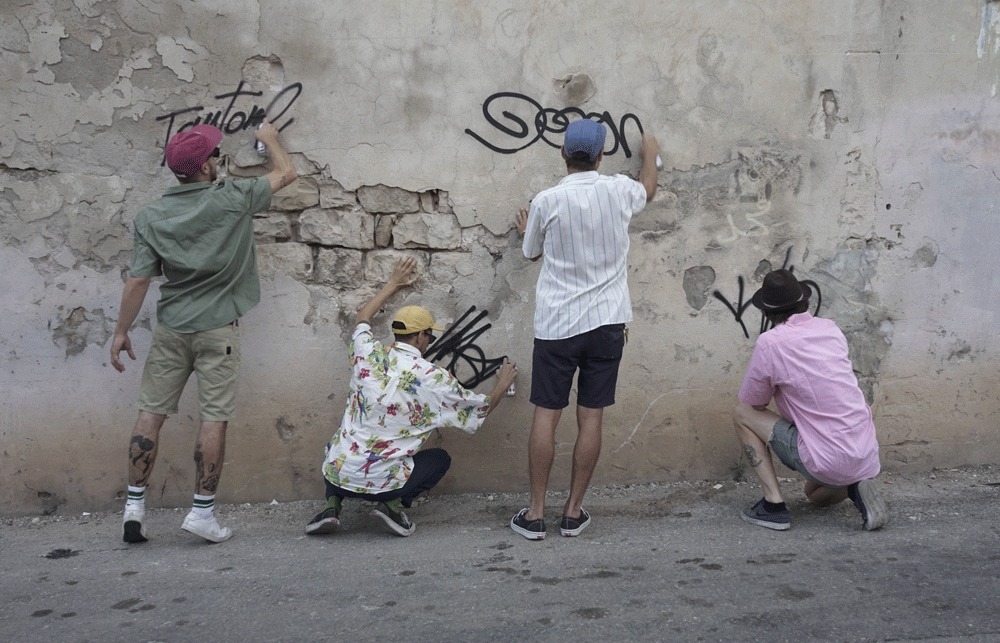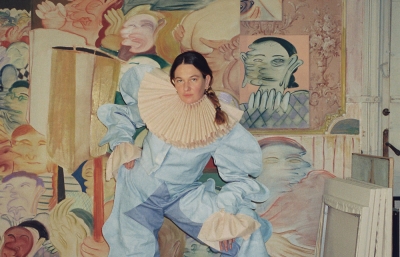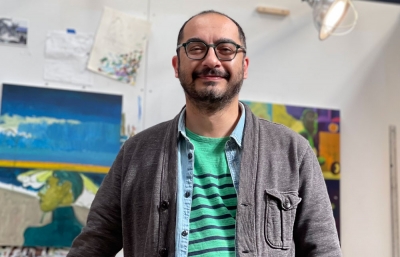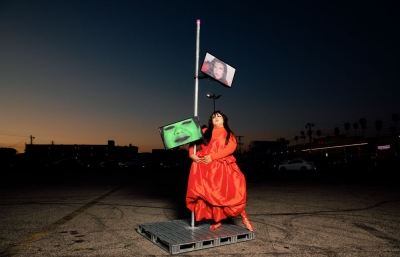Broken Fingaz
Utopian Collective
Interview by Doug Gillen // Portrait by Yona Preminger
Since the early 2000s, the collective Broken Fingaz has been using public space to craft their own instantly unique and recognizable universe. Blending illegal ephemeral actions with large-scale commissioned murals, they forged their own path on a road that has become increasingly traveled. Originating from the northern Israeli city of Haifa, their work offers both reflection and escape from a region fraught with social and political tension.
To understand the worlds that they create and the chaos often depicted in their hyper-graphic, visually arresting work, it’s helpful to understand the context in which Broken Fingaz was formed. We sat down with members Unga and Tant during a trip to Belgium this past spring (with help from Deso who had to take off before the interview was conducted) as they painted for the Crystal Ship Festival. The two created a picture of life on the fringe and the formation of one of the most energized crews to emerge from street art culture.

Doug Gillen: Help me out here. Officially and currently, Broken Fingaz is three or four?
Unga: Three is the core: active, working together. The fourth one is just really doing music the last few years. So he's still a good friend and we talk together about ideas sometimes, but there are three who are actually painting.
Unga, I know that you've been based in London. Do you still maintain a base in Haifa? Do you go back often?
Unga: Yeah, I've just been there. Tant used to live in Tel Aviv and he just moved back to Haifa. Deso was in Mexico for two years so we moved around but we always come back to Haifa. That's the headquarters.
Tant: Up until Covid we used to travel a lot together. For ten years we've basically been constantly moving.
How do you keep that dynamic? You're three, four individuals, but you operate as this single entity. It's not an easy thing to do.
Tant: Maybe from the outside it doesn't look easy, but for us, it's so natural. First of all, we grew up like this; Unga and I grew up together in a commune, and our parents, who are architects, also work together. I think we grew up into that group mentality…
You’ve probably been asked about this a thousand times, but from the outside, it's quite interesting to hear about growing up in a commune, in what you describe as an “eco-architecture space." It was called the Tav group, right? Not that you would've known any differently, but what was that environment like as a place to grow up?
Tant: So it was like a village. It's inside Haifa, inside the city, but it's in a valley that goes down to the sea. There were five buildings where they squatted, and we and our parents used to call them mushrooms. The houses are round buildings. It was a very good childhood.
Unga: We just got exposed to a lot of music, different people, and art. It was cool, it was very free, so that's why when Tant says it's normal for us, it’s because that’s what we saw: a group working together. This is generally the case in Israel because of the history. It's more socialist and you have the Kibbutz. That’s why it's not that rare to have this mentality.

So, pre-Broken Fingaz, were you guys still running about painting together?
Unga: Not really. We were just hanging together, skating, doing whatever, but then when graffiti came it just made perfect sense for us. We like to paint. We like to be with friends. We need the rush and the adrenaline of kids. And now that we can focus on something productive through it. It just felt like the greatest thing in the world and we wanted to do it forever even though we never ever thought that it would be like a career or anything.
I don't think anyone at that time thought that there was a career in it.
Unga: No, not at all.
What was Haifa like as a city around this period? We're talking early 2000s, mid-2000s, right?
Tant: It's not really a city, first of all. You call it a city and it's maybe the third biggest city in Israel, but it's like a village. It used to be a working class. There was basically not much happening, culturally. When we were teenagers we used to go to Tel Aviv for parties. I don’t think Graffiti didn't exist in Haifa until 2000.
What were you looking at then for inspiration?
Tant: Comics books. We didn't even call it art back then. We used to draw, print our stuff, and do paste-ups or we just did graffiti.
Unga: Horror movies, medical books, illustrations, a lot of that stuff was what we had in the earlier years. You have to understand that there were no art galleries. Even to this day in Haifa, there is not one proper gallery.

Growing up there, how would you describe your relationship with religion?
It's weird. It's mixed in Haifa, but also the history is working class, more left, socially and secular. It's the only city in Israel where you will have buses on Shabbat, on Saturday. So even in this sense, it's more laid back. It's not really part of your childhood but then when you grow up you understand that you were brainwashed a lot. Not so much about religion, but more like, “Then the Jews came from Europe and the land was empty and we just built a beautiful country.” Cool, sounds like a great story. And then slowly you grow up and you start to ask the question, "Hey, well, what about all those Palestinians who were here before."
Was this thing, we'll just call it politics, was that a factor in your early work? Was your work a response, a reflection of this, or was it not at all a factor?
Tant: I think in most of our work in the early years we tried to get away from this aspect. Living in Israel, it's all about this, and when you meet someone from abroad they probably will ask you about politics and what your thoughts are about the whole situation. We try to create our own utopian world and live in our imaginary land. Later on, we dealt with those issues, not all the time, I mean, as some of our works deal with politics. Most of them are more personal, I guess.
I feel like there's been a more direct conversation opening up on these subjects in recent years. Is that something that you're consciously doing?
Unga: It's not a conscious, strategic decision, but we realized that we feel more of a natural passion of needing to say something, not with the intention of changing people's minds, but because we have something built inside of us that needs to be released. It comes and goes so we can suddenly do something very political and then we feel free enough to just do a year of funny turtles or whatever and then go back to it. It doesn't have to be that I'm a political artist and that's all I do.
Tant: As far as murals go I think it started as a situation where you come to a place and try to react to what you see and what is catching your eye there, what is important to communicate to the world.
Unga: It's also almost a challenge for us. If we tell you about an idea and you can’t imagine that anyone would let you paint it on a huge building in the middle of town, yeah, that’s a challenge. But then our goal becomes to do it and have fun with colors that pop so people will just pass by and say, "This is great, thank you." And then, maybe with time, they wonder about what is going on, why is this guy doing this?" And they realize more of the story.

You talk about being motivated to make the work very colorful and graphic. For a long period of time, the content was quite sexually charged. What was the driving factor behind that? What was the role of the subject of sex in your artwork, and as something viewed by the public?
Tant: Actually, I think it never started as a provocative act. We just love to paint skeletons and naked women and it was our practice for a long period of time. Then we just started doing it in the street and we saw a reaction and that was interesting to see.
Unga: …But it was a little reaction because I do remember that we were in London and we were just amazed at how street art became such a thing, so mainstream, and with the street art tour, it's everywhere now. Back then the reaction was one of, "Wow, we're not used to it."
Where was the inspiration for the fat man?
Unga: I don't know. It's something I've always been drawn to paint. It was just fascinating to think of the shapes and the image of a shaved, bald man who I feel is such an international character. You see him in every country you go, the same fat and bald guy.
He has been a recurring image among many you've had, including skeletons and lizards, just a few things that have come through frequently. Are they just graphic interpretations of something in your head, just characters that you think are fun who don't necessarily have to have some deep symbolic message?
Tant: In the first place, you don't paint an image because you want to symbolize something. You paint it because you feel like painting it. Then, afterward, it becomes a story or it finds meaning within the piece. It can have different meanings, maybe. But at first, we just painted skeletons because we wanted to practice how to paint them.
Unga: There's a lot of instinct and then sometimes when you start with instinct, if something works for you or seems interesting, then you just keep doing it. You keep doing it and sometimes at the end, in retrospect, you understand why you did it and sometimes you don't. Sometimes there is not much meaning but it's just about repeating a motif so much until it's become something like a piece of clay that you can play with. When you paint something so much, it can lose its meaning and it's just a shape. As a painter, it's going to give you a certain freedom to approach it in an abstract way. You just use it as a tool.
Tant: Like an abstract language. But we built the language.
Unga: Sometimes the topic of the painting wouldn't be like what we depict. It's just a tool to deal with something that, for us, is interesting at the time. It could be about the colors or about the composition or about the expression. We just use what is in front of us or an image that we have already drawn many times so that people will see it and perceive that it's an image of still life or of a dog when actually, the painting is not about either. It's about whatever we were dealing with at the time.

Do you prefer to keep these meanings close to yourself, keep the paintings open for interpretation, or do you think that they should be accompanied by something that provides an explanation?
Tant: That's the reason that we do visual art. I mean, if we want to write an article or write a book, we'll describe it in words. When you do a painting it has to speak for itself as art, as something that you look at. If you're feeling something there might be a story, but the most important thing is that it will be interesting as a painting, not as something that you can write about the painting.
How do you maintain these ideas and this ethos? Is there a change moving from the street into the gallery and into the studio? What's similar and what's different?
Tant: They’re very different, I think. We're trying to adjust ourselves to every environment. Not every wall will work in a different place, and most of the works that we do outside do not necessarily work in a gallery or on a blank wall. When you do an outdoor painting it has to work within the environment. When you do a painting for a gallery it has to work by itself. It doesn't matter. You can move it from gallery to gallery, to a museum and it will still work the same.
Unga: Street art and graffiti are a lot about the context. It's about the location in the city, the architecture, and most of the time, the interesting street art is made by people that understand their surroundings. And then moving that into a gallery is just something completely new. You take some of the stuff that you learn in the street but you have to learn from scratch again. It is very exciting for us. I think that maybe six or seven years ago we started to get into painting a bit more because previously, everything was very flat. Even if we did an acrylic painting we were trying to imitate the effect so it looked like a flat print. Then we felt that when we made works for an exhibition that the process was a bit boring because once you did the sketch, you already would know exactly how the painting was going to look.
And we started to move a bit more into painting with oil paint and still-lifes without even knowing what we wanted to do. We wanted things to be more dynamic. At first, people were wondering what we were doing. They wanted skeletons fucking each other. Suddenly, I’m painting bananas with oil paint and not even sure why I'm doing it. But I felt a certain excitement that reminded me of the excitement I felt when I started graffiti. That's all I want to do. It gave us a lot of freedom. Once we did this and we started to do stuff that was a bit weirder for our audience, we got rid of the audience that was closed-minded and just wanted the same thing. The people who stick with you are the people who are in it for the ride and they're asking us to take them somewhere. They trust us and it's a great freedom because they understand. Maybe everything will not be your best work, but it's going to be interesting.

How does it differ when you're working on your own from when you're working together?
Tant: I think it's super important for us to be together. We're trying to meet at least a few times a year for a residency or to work together on an exhibition or a project with the intention to always bring something new to the game. When we work alone, I think it's also important and it gives a balance because each one develops his own skill or his own perspective. Then when we meet again, we react to those changes that each one of us has been through. It's a very good system. It’s like a very good school for us because we always have each other for feedback.
Unga: We built this little system that reminds me of something I saw in the Beastie Boys documentary not that long ago. The thing that inspired me the most, and that I feel we are lucky to have too, is the fact that they really gave each other the ability to experiment. If someone comes up with a weird idea, the others don’t look at it and give weird looks. They're willing to say, "Okay, we're not sure, but let’s try it." We will never reject something like that. If someone brings something and you're not completely sure, there's a total willingness to try. And then maybe we're not going to use it, but we're always going to try.

Have you guys started thinking about where that goes? How does Broken Fingaz go from being this cool entity that moves around and appears in so many different places? Can it go back and recreate the same energy or environment that comes from where you grew up? I guess my real question is whether it will plant roots somewhere more permanent.
Tant: Yeah, I think it was a dream for a long time, to have this community back. For a few years I think I was really motivated to make it happen somehow. But then you grow up, and each one has family and you get settled a little bit it’s hard to move and to build something. Even for our parents, it worked for ten years, and then we got kicked out of the place. They tried, but they never managed to make it happen again. It's hard.
Unga: I think if you ask us about the dream scenario it would be to live near the beach or near nature, but not too far from a city. To be surrounded by friends, to have a sense of community, and to create art. That's it. None of us want to be rich just to buy fancy cars, but we do want to have a nice studio and be able to choose the projects that we want. I do believe it will happen.
Tant: You need to put your ego down if you want to live in that kind of community, collective or crew, whatever. You have to, like, take your ego down and be super open about everything.
The BFC Book by Broken Fingaz is now available at BrokenFingaz.com






